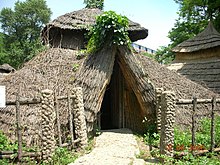Xinle culture
The Xinle Culture ( Chinese 新 樂 文化 / 新 乐 文化 , Pinyin Xīnlè wénhuà , English Xinle Culture , also called Xinle Culture of the Lower Class 新 乐 下层 文化) is the earliest Neolithic culture in northeast China , which was found in the area of the Lower Liao River ( Xia Liao He diqu ) in Liaoning . It was discovered in 1973 and dates from 5500 to 4800 BC. Dated.
There was evidence of the cultivation of millet ( 黍 , shǔ , English broomcorn millet - "Panicum miliaceum") and the domestication of pigs .
The eponymous Xinle site was discovered on the west side of Beiling Park (北陵), on the border of the Huanggu and Yuhong districts of Shenyang in the Liaoning Province of the People's Republic of China .
Mainly chipped stone implements , also polished stone implements and also typical microliths were discovered on tools . On pottery egg products , there are many jiashatao -Töpfereierzeugnisse (jiāshātáo夹砂陶), mainly with pressed "之" (zhī) -zeichenförmigen lines ornaments and "chord patterns" (Xianwen弦纹;. English bow-string pattern) decorated on vessel forms there are simple, deep, belly-shaped guàn äße vessels (jugs) and “vessels with a slanted mouth” (xiékǒuqì 斜 口器). A relatively large number of exceptionally fine gagat ( black amber ) as well as agate and jade artefacts were discovered, none of which were produced at this location.
Discovered dwellings had a floor area of twenty to one hundred square meters.
The Xinle site (Xīnlè yízhǐ 新 乐 遗址 Xinle site) - in the middle layer of which relics of the Pianbaozi culture type (also common in the area of the Lower Liao River) were discovered - has been on the list of monuments of the People's Republic since 2001 China (5-24).
museum
In 1984, the Xinle Sites Museum ( Xinle yizhi bowuguan ) was established, showing a reconstructed seven thousand year old village and depictions of everyday life at the time.
photos
See also
- List of Neolithic sites in China
- Xia Liao He diqu 下 辽河 地区 ( Liaohe plain or area of the Lower Liao River )
- Pianbaozi Culture偏 堡子 文化 (Lower Liao River Area )
literature
- see. Page no longer available , search in web archives: Center for the Study of Chinese Archeology
- Shengyang Shi Wenwu guanli bangongshi 沈 阳 市 文物 管理 办公室: “Shenyang Xinle yizhi shijue baogao” 沈 阳 新 乐 遗址 试掘 报告, Kaogu xuebao 1978.4, pp. 449-466
- Shengyang Shi Wenwu guanli bangongshi, Shenyang gugong bowuguan 沈 阳 市 文物 管理 办公室 、 沈 阳 故宫 博物院: "Shenyang Xinle yizhi di-er ci fajue baogao" 沈 阳 新 乐 遗址 第二 次 发掘 报告 (The second excavation in Shenyangle Xinle) . Kaogu Xuebao 1985.2, pp. 209-222
- Li Huichun 李惠春: "Shenyang Xinle yizhi" 沈 阳 新 乐 遗址, Zhongguo wenhua bao中国 文物 报, July 24, 1987, p. 3
- Li Xiaozhong 李晓 钟: “Shenyang Xinle yizhi 1982–1988 nian fajue baogao” 沈 阳 新 乐 遗址 1982–1988 年 发掘 报告, Liaohai wannwu xuekan辽 海文物学 刊, 1990.1, pp. 7–24
- Shenyang Yinle Yizhi Bowuguan, Sheng Yang Shi Wenwu guanli bangongshi沈阳新乐遗址博物馆,沈阳市文物管理办公室: "Shenyang Xinle Yizhi Qiangjiu Qingli fajue Jianbao"辽宁沈阳新乐遗址抢救清理发掘简报, Kaogu 1990.11, pp 969-980
reference books
- Cihai ("Sea of Words"), Shanghai cishu chubanshe, Shanghai 2002, ISBN 7-5326-0839-5
- Zhongguo da baike quanshu : Kaoguxue ( Great Chinese Encyclopedia : Volume Archeology). Zhongguo da baike quanshu chubanshe, Beijing 1986
Web links
- Xinle Site Museum (English)
- Xinle Site Museum (English)
- Xinle wenhua - Shenyang diqu ( Memento from February 21, 2014 in the Internet Archive ) (Chinese)
- Shenyang Xinle Ruins (English)
- 属 偏 堡子 文化 的 遗址 最早 发现 于 新民 县 偏 堡 ⑧ ( Memento from August 4, 2012 in the Internet Archive ) (Chinese)
- Xinle Site General Information about Investment Environment of Shenyang ( Memento from August 5, 2012 in the web archive archive.today )
- Xinle yizhi (Chinese)
Individual evidence
- ↑ a b Xinle Site General Information about Investment Environment of Shenyang (English) ( Memento from August 5, 2012 in the web archive archive.today )
- ↑ Page no longer available , search in web archives: myy.cass.cn
- ↑ a b c d e Cihai , p. 1890.





